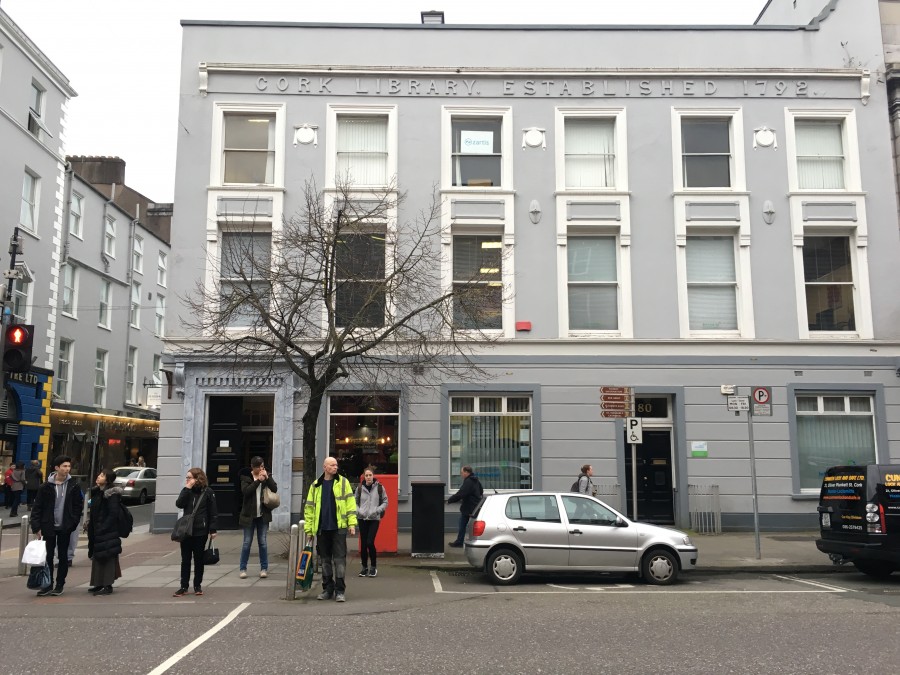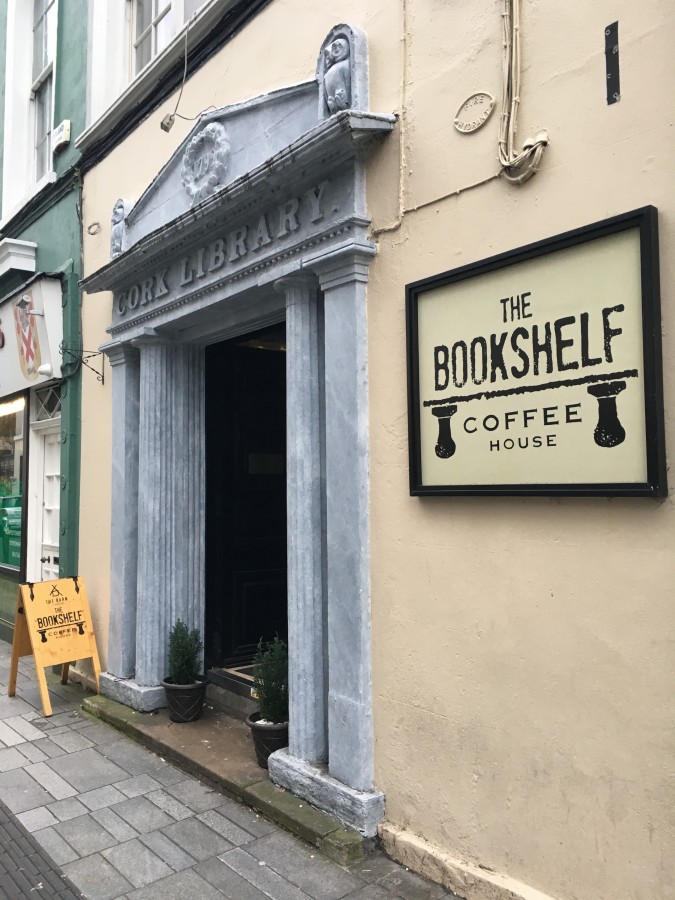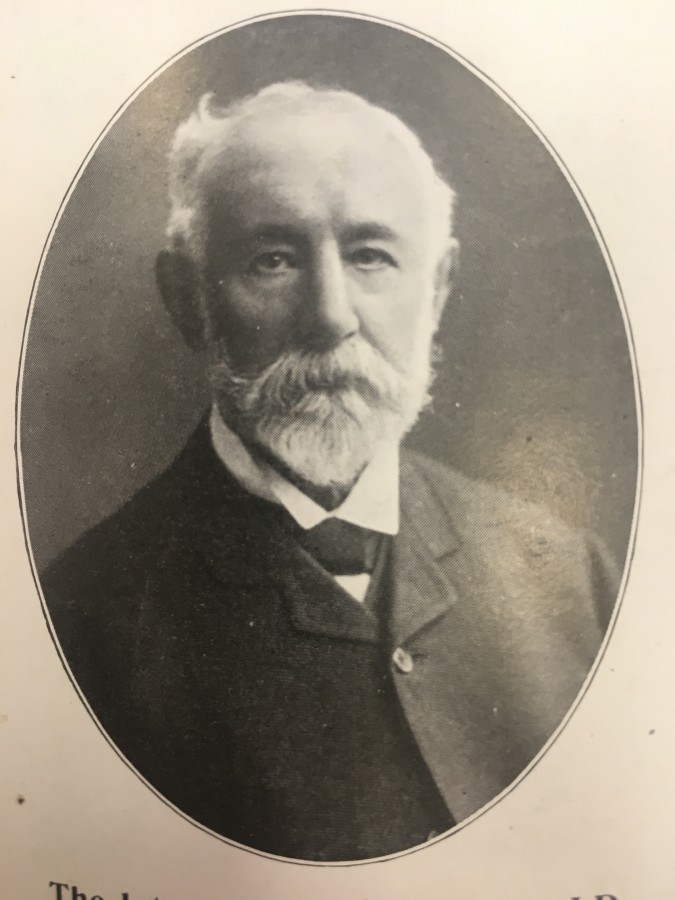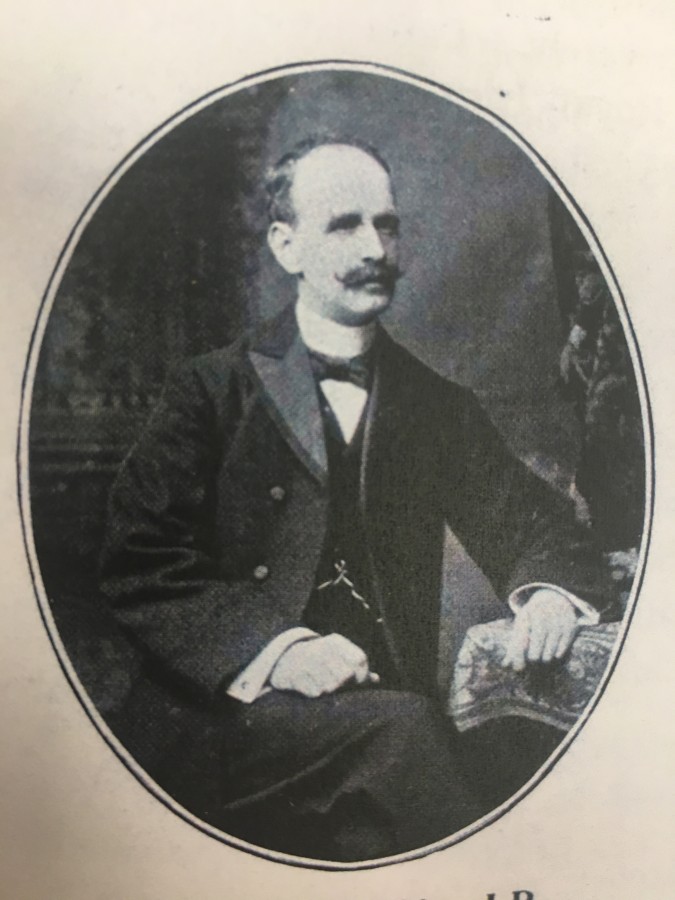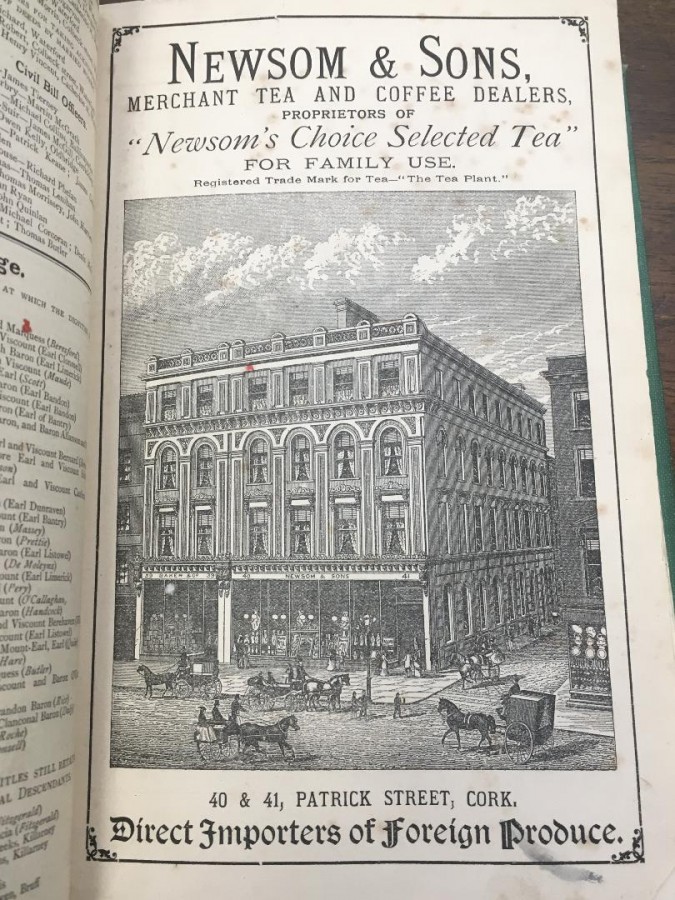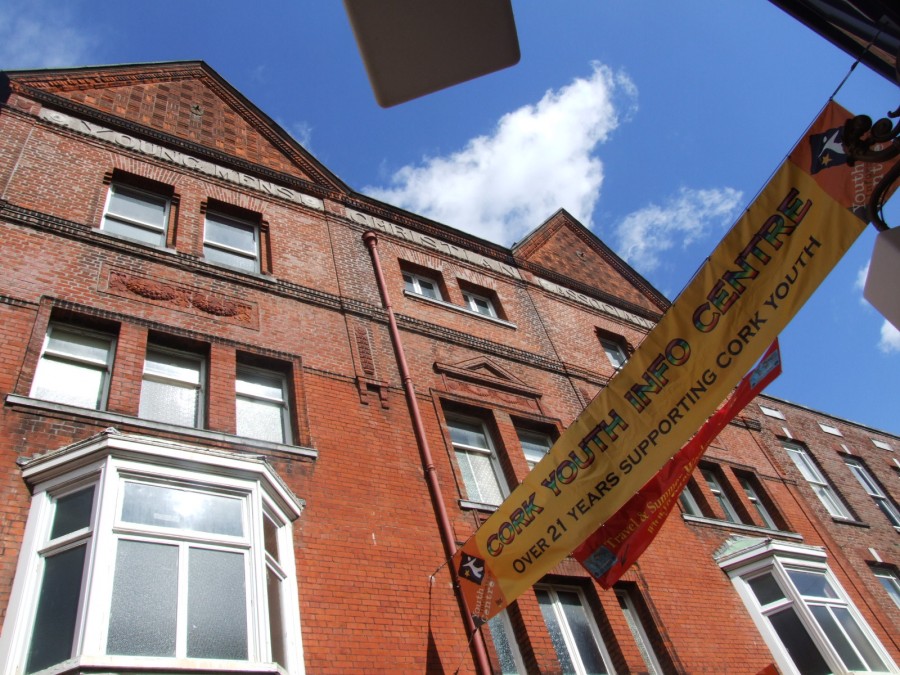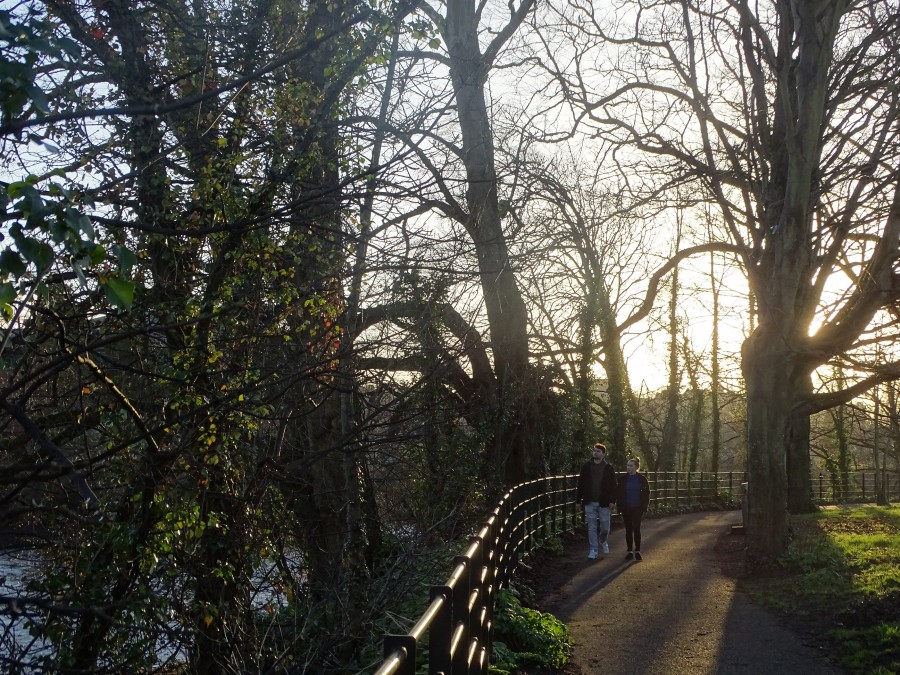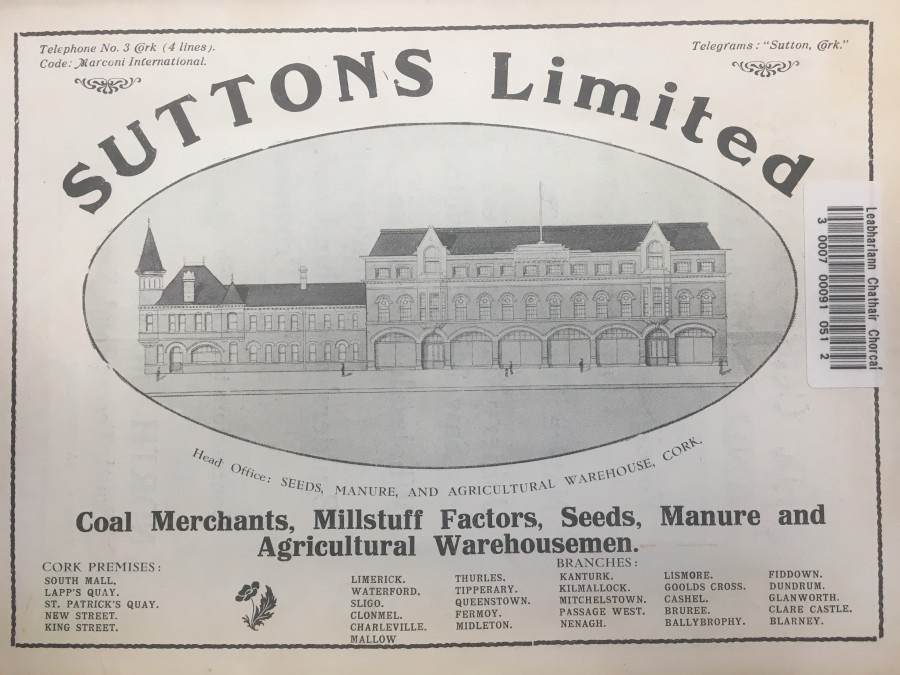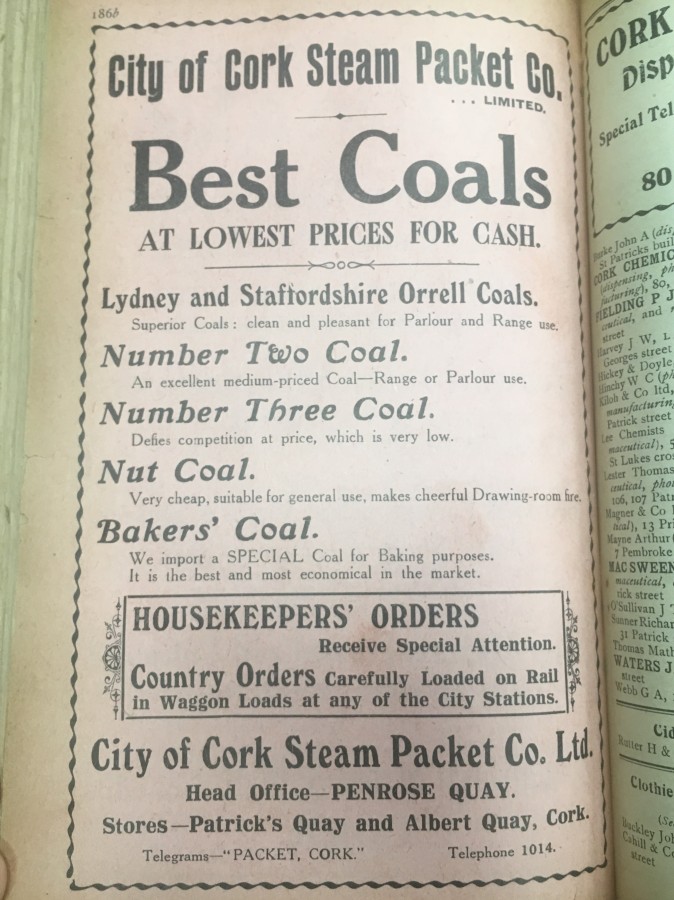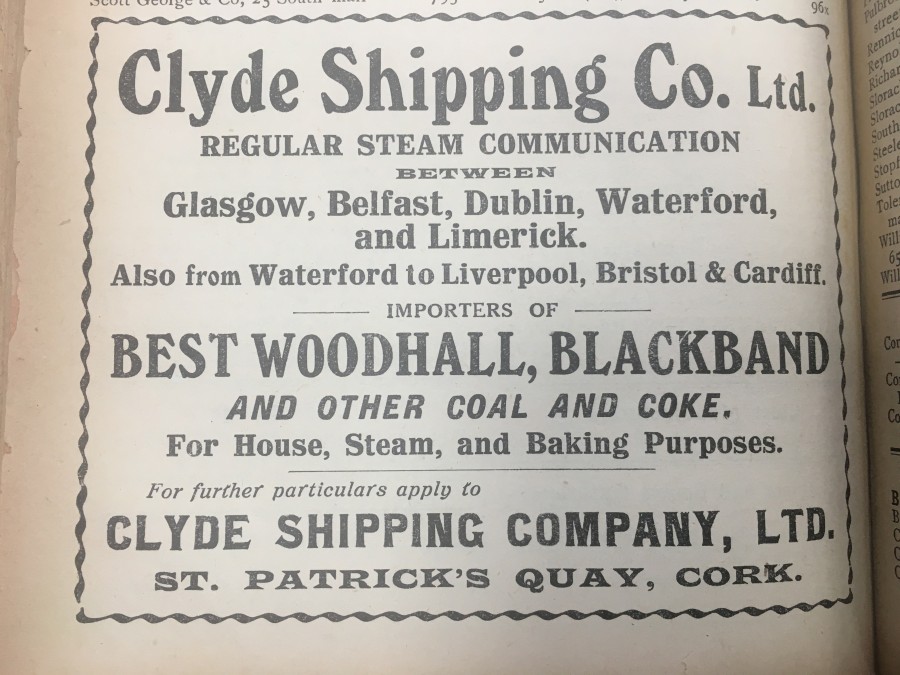Kieran’s Our City, Our Town, 8 February 2018
Kieran’s Our City, Our Town Article,
Cork Independent, 8 February 2018
Stories from 1918: The Pembroke Street Library
Two owls on a coffee shop entrance and a date 1792 are the only remnants of the Cork Subscription Library on Pembroke Street. At the annual meeting of the subscribers to the Cork Library, Pembroke street, held on 4 February 1918 Michael Murphy, Solicitor and Honorary Secretary read the auditors’ report, which was published by the Cork Examiner a day later. A profit of £45 l6s 3d was made comprising £22 in additional subscriptions and £17 for the sale of waste paper.
Three years previously in 1915 the library had been put into a “good condition of repair”, with the result that there was no expenditure under repairs for 1917. The salaries of the librarian and assistant had not been increased since the war commenced. At the 1918 meeting salary rises was one of the principal themes. An increase in the subscription of 4s a year was proposed i.e. from £1 1s to £l 5s. The alternative to an increased subscription would be to cut down the supplies of papers, periodicals, magazines, etc. According to Mr Murphy, Cork Library offered advantages far greater than such libraries in other large centres, and where the subscription was up to £2 2s. Canon Tracy said that subscribers were very pleased with the manner in which the library was conducted at the time, and the committee and officials had “carried out their duty well”. As regards the increase in the rate of subscription, considering the valuable services given in the library, he was “surprised that the proposal was not more than 4s”.
On the motion of Canon Tracy and seconded by Dr E Murphy, the President of the Library, Professor William F Stockley, was unanimously re-elected, and Mr Coroner Horgan, solicitor, Honorary Treasurer. In 1905, Professor Stockley has been appointed professor of English at University College Cork. He occupied the chair until his retirement in 1931. He was president of the Cork Literary and Scientific Society from 1913 to 1915 and President of the Cork Library Committee from 1913 to 1930.
Unique in the country, the Cork Subscription Library was founded at a time when books were scarce, expensive and not easily attainable. The library catered successfully throughout its long period of use, for the reading wants of many generations of Cork men and women. The brightest and best in the intellect of Cork were closely associated with the Cork Library ever since its inception. In 1792 the library was based on Cook Street to begin with and then new premises were designed by noted architect Thomas Deane.
In 1801 the library had eight life members and 143 ordinary members. The committee for that year comprised notable Cork personages – Dean St Lawrence, President, Dr John Longfield, Vice-President; Doctors Charles Daly, Richard Walsh, J Bennett, T Bell, and Messrs A Lane, S Wiley, J Spearing, St Leger Aldworth, W Trant, T Rochfort, S Richardson, P Stacpole, Mr Maxwell, H Wallis, B Bousfield, N Mahon, and E Penrose. Dr T Westropp was treasurer.
The library catalogue in 1801 ran to a volume of 31 pages and had 627 items – History, Antiquities and Geography (146), Biography (38), Politics and Political Economy (21), Morality (13), Law (4), Divinity, Sermons (7), Metaphysics and Arts (62), Medicine, Surgery, Anatomy and Chemistry (83), Natural History, Minerology, Botany, and agriculture (26), Voyages and Travels (84), Belles Lettres, Poetry, Criticism, and Miscellany (108), Novels and Romances (25), and Dictionaries and Grammars (10). By 1820 the number of books in the catalogue had risen to 2,013 with membership growing to 385.
Any person wishing to become a member of the library had to be proposed by a library member and seconded by another. After his and their names had been exhibited for five days in a part of the library, the subscription for the year of one guinea, together with the admission money of half a guinea had to be deposited with the treasurer. The proposed member was then balloted for in Committee, and if a majority of those present appeared in favour of him, he could be admitted. On signing the rules, he was entitled to all the privileges of a member of the society. The names of ladies, however, were not posted up, but kept in a closed book. The library was to be open for members of the library to read and send for books from 11am to 5pm from 1 February to the 1 November; and from 11am to 4pm from 1 November to 1 February except Sundays, Christmas Day, and Good Friday, Members could only take one book unless an additional subscription of half a guinea for an additional book.
By the year of the Cork Subscription Library’s closing in 1938, the reading room had upwards of 20,000 volumes of general literature, the daily and weekly newspapers, periodicals, illustrated papers and magazines. The library contained a central, spacious and comfortable writing room, ladies’ rooms and gentlemen’s smoking room. The members of a subscriber’s family were entitled to the full privileges of the Library whilst the annual subscription was £2.
Captions:
932a. Front façade of the former Cork Subscription Library, South Mall (picture: Kieran McCarthy)
932b. The owls of Pembroke Street (picture: Kieran McCarthy)
McCarthy: Summer 2018 slated for Tramore Valley Park Opening
Independent Cllr Kieran McCarthy has welcomed the response of the Director of Recreation and Environment of Cork City Council David Joyce that Tramore Valley Park is on track to open to the public in the summer of 2018. In reply to a question at the last City Council meeting by Cllr McCarthy, Mr Joyce outlined that there are several health and safely concerns that need to be resolved before the site opens to the public.
Cllr McCarthy has remained consistent in lobbying to get the park open; he noted; “vast amounts of public money has been invested to transform this former landfill into a c.160 acre public park. An extra allocation of funding within the City Council’s 2018 budget has allowed for the opening of the park. I remain committed to putting pressure on the officials to open this significant park area, which will serve all of the city and beyond its boundaries”.
Cork Bridges and Funding 2018
Cork City Council Press Release, 1 December 2018:
Three of Cork’s most important heritage bridges are to undergo either restoration or significant maintenance works this year.
St Patrick’s Bridge:
Cork City Council, in conjunction with Transport Infrastructure Ireland (TII), is to begin preliminary works on the repair and rehabilitation of the iconic St. Patrick’s Bridge next week.
This bridge is representative of 19th century design and construction and its restoration will be sympathetic to these values as well as to its unique heritage and historical importance. It is expected that the €1.2 million works will have minimal impact on pedestrian and traffic movement and will be undertaken in two phases.
SSE Airtricity Utility Solutions Ltd. has been selected by Cork City Council to undertake phase 1 preliminary works and they have appointed renowned Italian lighting restoration specialists, Neri to complete the project. Neri has worked extensively in Dublin including on lighting restoration at O’Connell Bridge. The existing four heritage standards (lamp columns) on St Patrick’s Bridge will be removed during the week commencing February 5th and an additional four standards, currently in storage, will be sent to Italy for repair and restoration.
This will involve returning the columns to their original unpainted bare metal state, repairing weather damage, protecting and repainting the standards. As part of this process, moulds will also be created to make additional duplicates columns. Upon completion, the 12 restored/replicated standards will be returned to the bridge in September complete with new lantern heads with LED fittings where they will be remounted just as when the bridge was first built. In the interim period, six standard temporary lighting columns will be put in place to help illuminate the footpaths during darkness.
Cork City Council is in the process of issuing a tender for phase two of the works which it expects will begin in early May. This phase of the works involves the removal of all vegetation and algae from the bridge, the cleaning and repair of all stonework and the re-pointing of missing or defective masonry joints. Proposed works also include the replacement of the footpath and carriageway surfacing together and new road markings. Existing traffic lights, elevation and architectural lighting and directional signage will also be upgraded.
It is expected that all works to St. Patrick’s Bridge will be completed by mid October.
St Vincent’s Bridge:
A tender is also due to be launched next month for critical maintenance work on St Vincent’s Bridge which connects the North Mall and Sunday’s Well to the junction of Bachelor’s Quay and Grenville Place. Detailed design to assure the continued usage of this bridge is being progressed. As part of these works, lighting on the bridge will also be improved.
Daly’s Bridge:
Refurbishment works will also begin on the iconic Daly’s Bridge in September this year to repair extensive corrosion and damage.
A tender has been launched seeking consultants to undertake design and civil works preparation. It is intended to award this contract by the end of next month. A contract for the civil works will be tendered in the coming months with a programme of works likely to start on site in September. The Department for Transport, Tourism and Sport is funding the project.
Kieran’s Our City, Our Town, 30 January 2018
Kieran’s Our City, Our Town Article,
Cork Independent, 1 February 2018
Stories from 1918: Dobbin, Ogilvie and Hibernia Buildings
The first week of February 1918 brought a focus to picketing and strikes on Cork’s streets. Picketing was held outside Messrs Dobbin, Ogilvie and Co, on King Street (now MacCurtain Street). The strike concerned 54 workers, 37 females and 17 males.
A prominent member of the Transport Workers and General Union, when interviewed in the Cork Examiner described the origins of the dispute. The dispute has its origin in demands made in October 1917 for 18s per week for female hands who were being called upon from time to time “to perform heavy work, men’s work, hoisting of full barrels, etc”, and 30s per week for men, which included firemen. An advance of 2s per week was offered to, and rejected by the men on that occasion, and an advance of 5s per week to female workers, which was accepted.
The men were told they would receive more favourable consideration if they left their trade union. They did not and were fired. The firm gave references to them, and days later five workers at the firm were each asked to perform the work of those put off. They refused, got a week’s notice and the rest of the workers decided to strike. Grievances at the company were not resolved until 1919.
The business, Messrs Dobbin, Ogilvie and Company, which was established in the year 1855, was a successful enterprise. It developed to such an extent that a larger premises was needed. The company moved from premises on the South Mall and on Princes Street. In 1877, newly erected buildings, known as the Hibernia Buildings, on King street were occupied, and trade was further developed.
In the Irish Builder newspaper for 1883, a fire is recorded on the site. The paper recorded that the business comprised three buildings; the main or centre structure contained the counting-house and the general warehouse, in which all kinds of merchandise were stored. Brandies, whiskeys, oils, chandlery, and other inflammable materials were among the goods that filled this large section. At the right stood the building in which the confectionery was manufactured. The building at the left side was the one in which the important work of tobacco spinning was carried on. The tobacco factory was deemed to be fitted with “machinery of a very expensive and elaborate character”.
Following the fire, some of the building was remodelled by Henry Arthur Hill and was known for its cupola atop it. In the year 1891 the business was converted into a joint stock company, and continued to expand. Like many other trading companies, it had its good years and lean years. It was well known for its Cordangan Mixture, Douglas Mixture, Irish Roll, and Plug as well as its jams and jelly marmalade. For many years, the company, in addition to its general business and tobacco manufacture, was engaged in the army canteen trade on a very considerable scale, and the cessation of World War I involved a largo reduction in the extent of the company’s operations. In the early 1920s, the establishment of the Customs barrier between Great Britain and the Irish Free State involved a further extensive loss of business, as the company’s cross-Channel tobacco trade, a large percentage of the total, was relinquished. The firm went into voluntary liquidation in April 1926.
In Hodges Cork and County Cork in the Twentieth Century (1911) James Ogilvie is listed as born in 1840 and educated privately. He was as a Justice of the Peace for the county and city, member and ex-Chairman of the Cork Harbour Commissioners Board, Chairman of the Cork Spinning and Weaving Company, Ltd, Director of Eustace and Company, Ltd, Director of F H Thompson and Son, Ltd, Director of the Cork Commercial Building Company, ex-President of the Cork Literary and Scientific Society, member and ex-President of the Cork Incorporated Chamber of Commerce and Shipping, Trustee and Member of the Committee of Management of the Cork Savings Bank. He died at his residence in Queenstown in September 1910.
In his obituary on 2 February 1942 in the Cork Examiner Sir Alfred Dobbin was born in 1853, the son of Leonard of Belfast, and later of Cork. Early in life he displayed a great business acumen, which prompted him to play no small part in the building up of Cork’s commercial importance. He was appointed High Sheriff of Cork in 1900 and in the same year was knighted by Queen Victoria. Within a few years he was also appointed Deputy Lieutenant for Cork City, a position which he held until the change in regime abolished the post.
During the Irish War of Independence the Dobbin house at Frankfort, Montenotte, was totally destroyed by fire. On another occasion he was fired upon but it was made public at the time that the bullet hit a button in his clothing and was deflected, thus saving his life.
Sir Alfred’s first wife, Miss Margaret Reid Ogilvie died in 1883. after seven years of married life. Lady Kate Dobbin was the second daughter of the late Mr William Wise, solicitor, of Bristol. Both Sir Alfred and Lady Dobbin took a keen interest in art. Kate Dobbin was a well-known exhibitor at exhibitions of paintings and photographs.
Captions:
931a. Sir Alfred Dobbin, in Hodges Cork and County Cork in the Twentieth Century, 1911 (source: Cork City Library)
931b. James Ogilvie, in Hodges Cork and County Cork in the Twentieth Century, 1911 (source: Cork City Library)
931c. Former Hibernia Buildings, MacCurtain Street, built initially by Dobbin, Ogilvie & Company (picture: Kieran McCarthy)
Kieran’s Our City, Our Town, 25 January 2018
Kieran’s Our City, Our Town Article,
Cork Independent, 25 January 2018
Stories from 1918: The Newsom Legacy
This day 100 years ago, 25 January 1918, brought the news to Cork citizens that one of the its respected merchants had passed away – that of John Charles Newsom. The Cork Examiner records that at a meeting in the City Council Chamber in Cork City Hall Alderman Simcox proposed a vote of sympathy with the Newsom family of whose death they were all sorry to hear; “The late Mr Newsom is a great loss to the commercial community in Cork. He was a member of many public boards, notably the North Infirmary. He gave lavishly to many of the charities in the city, and not only did he contribute to public charities, but he also gave privately. The poor of the city would deeply regret his loss, and frequently large crowds could be seen outside his place from year’s end to year’s end”.
The announcement of the death of John Charles Newsom took place at his residence Temple Lawn on Blackrock road. Born in 1838, he was a son of Samuel Newsom, and grandson of the founder of John Newsom and Son. In the wake of the Napoleonic wars and the consequent depression, Quaker merchant families began increasingly to concentrate on developing a new style business based on combinations of retailing and wholesaling. They took on insurance and shipping agencies and increasingly began to take on a rentier or landlord role. John Newsom set up his business circa 1816. His firm was situated at 109, St Patrick’s Street. In the Cork Constitution, on 5 October 1830 it details some of the diverse products that John Newsom was importing – “100 casks of new mustard, 30 boxes of Kensington candles, Jamaica coffee in tierces and barrels, Double Berkley cheeses in baskets, fine salad oil in half-chests, Carolina rice in tierces, cotton and linen wick in bags, vinegar from Bordeaux, Zante currants, Italian liquorice, isinglass, citron and candy, pearl and Scotch barley, split peas, chocolate, patent and shell cocoa, wax and spermacetti candles”.
John Charles entered the family business early in life. When the firm was made a limited company in June 1899, he became its chairman, and his brother, Samuel H Newsom became Vice Chairman. Incorporated for many years in the business was a wholesale sweet and confectionary branch trading under the name of Baker and Co.
As a young man John Charles became interested in the Temperance Movement, and as the years went by this interest developed considerably. He developed the rallying posters and posted them in the city and region. For many years he was President of the Irish Temperance League. In one of the last speeches he made in public, delivered in 1916, he referred to the starting in 1862 of refreshment rooms in Cork City for the purpose of supplying the working classes with a substitute for intoxicating drink. The committee was Francis W Allman, Francis Guy, Edward Cleburne, Denis Brennan, Robert Scott and Newsom himself. The enterprise was a success. It was years later before it was introduced in other cities like Liverpool and Bradford. The committee also chaired one of the two steamers of the Citizens’ River Company called the Citizen. In this, during the summer months, evening excursions round the harbour were given. The ticket cost sixpence, while for an extra two pence refreshments were supplied in the shape of coffee and buns.
In 1894 John Charles was a proud President of the Cork Young Men’s Christian Association with its circa 850 members. The YMCA societies were founded across Ireland from 1849 onwards and were the brainchild of Revered Dean O’Brien. By 1894, the one in Cork was the only one that remained. In other towns and cities once flourishing societies became split up, and gradually disappeared, their places being taken by other associations.
John Charles campaigned for a new building and merchants like him contributed generously towards one on Marlboro Street. On 2 March 1894, a gorgeous and spacious red brick building opened. Designed by architect William Henry Hill, it was built by John Delaney and his team. The Cork Examiner, the day after the event recorded that on the ground floor there was lecture hall, at the southern end. On the first storey was a reading room, secretary’s office, retiring room, and junior members’ room. On the second storey was situated a classroom for educational purposes and rooms for the committee, honorary secretary, and caretaker. On the top storey was the gymnasium. The entire cost of construction has been about £5,000, £850 of which was expended in purchasing the ground and chapel.
As an Elder of the Quakers, John Charles Newsom took a leading part in all their religious and social activities. Another society in whose work John Charles played a very active part was that for the Prevention of Cruelty to Children, of which he was honorary secretary. He was one of the oldest trustees of the North Infirmary. He was a Harbour Commissioner with the Port of Cork. Another position he held was that of Chairman of the Cork Improved Dwellings Company, which under his able guidance, the company built houses (Industry Place, Hibernian Buildings & Rathmore Terrace) for the working classes at a reasonable rent.
Captions:
930a. Advertisement Guy’s Commercial Directory of Cork 1883 for Newsom’s Merchant Tea and Coffee dealers, located at the corner of Marlboro Street and St Patrick’s Street (source: Cork City Library)
930b. Former YMCA Hall, Marlboro Street, which initially opened in 1894 (picture: Kieran McCarthy)
Kieran’s Question to CE, Cork City Council Meeting, 22 January 2018
Question to CE:
To ask the CE about the work programme and timeframe for Tramore Valley leading up to its opening to the general public this year? (Cllr Kieran McCarthy).
Motions:
That the missing street plaques be replaced at Dalton’s Avenue and Sheares Street, as well as the Sráid An Chapaill Bhuí at the Roundy House pub side on Castle Street (Cllr Kieran McCarthy).
That Cork City Council’s future Arts Plan be compiled and published (Cllr Kieran McCarthy)
Cllr McCarthy: Vast Potential for City’s Tourism
Press Release:
The meeting last week between Cork City councillors and Fáilte Ireland was a productive wake-up call to the competitive nature of tourism, and what type of product is invested in nationally according to Independent Cllr Kieran McCarthy.
Cork City’s tourism needs a vision for its future, a realistic plan, pressure for change and actions to be executed according to Fáilte Ireland Executive Jenny De Saulles of Ireland’s Ancient East (IAE) programme.
Ms De Saulles made the calls to Members of Cork City Council who recently received a presentation by her on challenges for Cork City within the IAE. Whereas the tourism industry in general is in a good place – growth and jobs- can be see, there are challenges with the Impending Brexit and making sure that tourism creates sustainable jobs and business.
Cllr McCarthy noted “Fáilte Ireland has an ambitious growth target of 3.4 % by 2028. The ambitions places pressure on future potential tourism sites to be of a high quality, unique and a signature experience; this has a knock-on effect on what the city should aspire to for the future in its tourism product”.
Ms De Saulles outlined that Cork is well positioned between the Wild Atlantic Way and Ireland’s Ancient East, international access is good and Irish Hotel Federation works hard in the region. The City has good festivals and a range of visitor experiences. The City’s tourism has vast potential for growth and must consider where that growth should be, and what role Cork City Council as a local authority should be.
Cllr McCarthy noted; “the questions we received revolved around key questions, does Cork City need an international signature tourism site? what does the visitor want? should we develop the city’s extant tourism products? What is the role of a local authority in tourism in supporting a tourism product? I found the meeting very productive to discuss the future of Elizabeth Fort and the Old Shandon Butter Exchange building. Small scale funding is available for both and should be moved upon quickly. It was clear from the discussion that the city needs a strong joined up thinking tourism strategy for the future”.
Kieran’s Our City, Our Town, 18 January 2018
Kieran’s Our City, Our Town Article,
Cork Independent, 18 January 2018
Stories from 1918: Save Our Food
With war raging since 1914, Cork like many European cities suffered food shortages. In January 1918 Cork Corporation continued to be pressurised by citizens to react to protect food supplies for basic living standards. To discuss and broker some steps of resolution to the supply problem, on this day 100 years ago, 18 January, a public meeting was convened by the Lord Mayor, Cllr Thomas C Butterfield in the Council Chamber, City Hall. It was held at the request of an agreed resolution passed at a meeting of the City Council.
Addressing the meeting, the Bishop of Cork, Dr Cohalan proposed a number of resolutions: “(1) That a Committee be formed, consisting of food producers, men engaged in the cattle, grain, potatoes, pig, butter, eggs and milk trades, to report on the food supply of the country, and on the means to be adopted for its conservation; (2) That it is the duty of merchants to retain for the use of the people the existing supplies; (3) That the following [persons] be requested to act on the Committee, and to report to a general meeting of citizens to be held on Friday, 25 January 1918”. The High Sheriff Mr O’Connor formally seconded the resolution.
Present at City Hall were Mr Lucey (chairman of the South of Ireland Cattle Trade Association), as well as Councillors and business representatives. Lord Mayor Butterfield highlighted that citizens were living in “very serious times”, and they wished to retain “the produce that was necessary for the people of the country”. He declared he was not knowledgeable to declare whether there was a surplus quantity of food in the country but they should do more to import necessities, such as coal and wheat.
A number of people spoke at the meeting. Mr McCurtain said he wished to support the motion. He had mined down into the figures of the Cork Harbour Board regarding the export of food supplies. He revealed that as far as those figures and statistics were obtainable, they showed that necessary food stuffs for the people were being exported at what he described as “an alarming rate”. He noted; “if some definite action is not taken and an effort made to hold supplies of food for the people, they would drift into a very serious state of affairs. Mr McCurtain placed the responsibility of retention of adequate supplies on the merchants who were making money. He called for them to re-organise their export of supplies without any financial loss to themselves.
Mr Seán Twomey considered that a statement or suggestion should go forth from the meeting to the merchants and exporters, asking them to export a lesser amount of food than they had been doing up to that moment. Mr T Barry noted cartloads of dead meat were still being sent away, and such exportations needed to be stopped. Mr Delea supported the motion describing that poor people who could not depend on any certain market were starving, and it was a shame that any foodstuffs should be sent out of the country. Mr Houston asked for the merchants of the city to be called upon to take immediate action to provide some funding for the successful working of a proper supply scheme. There were plenty of funds in Cork for such a purpose; “we have merchant princes in our midst, and it is their duty to take steps to sustain the working classes in the present crisis. Those merchants should provide a central fund for the purchase of food for the citizens of Cork”.
Mr Houston drew on a proposition that had been put forward in Dublin, where the merchants were called upon to provide necessary funds. In Limerick they had funds to the extent of £10,000 already guaranteed by the merchants, and he did not see any reason why Cork Corporation should not pledge their rates to such an extent as to be able to purchase and store the necessary food for the citizen. In Old Castle, County Meath, a similar scenario was being pursued.The banks had even issued overdrafts on the signatures of the local representatives, in order that the situation would be met and the necessary food provided. That was a matter that should be taken in hands in Cork. Mr Houston pitched a resolution to the effect that the Cork merchants should form a Supplies Committee to raise funds for the provision and storing of food for the people and the selling of it to the people as required. He outlined the scheme started in Dublin and said at that moment in time the first duty of the people of Ireland was to run the food supplies of the country.
Bishop Cohalan’s motions were carried unanimously, and the meeting ended. Other meetings followed in the ensuing months. The cause was also taken up by the Sinn Féin representatives in the region but in general it was the sentiment of protectionism that prevailed more so than progressive steps to resolve a deepening problem. Other challenges such as the conscription call for Irish citizens also came into the play as the year 1918 progressed (to be discussed in weeks to come in the column).
Note: All the 2017 Our City, Our Town columns can be accessed on my website www.corkheritage.ie under the index to the Cork Independent column section.
Secret Cork, which is my 2017 book, and published by Amberley Press, is now in Cork bookshops.
Captions:
929a. Suttons Building, South Mall, one of the key coal merchants in Cork in 1918, from Cork: Its Chamber and Commerce (source: Cork City Library)
929b. Advertisement for the importation of coal from the City of Cork Steam Packet Company, from Guy’s Directory of Cork, 1917 (source: Cork City Library)
McCarthy: Striving for EU Green Capital a Must
Press Release
There are calls for Cork City Council to work more towards securing the EU Green Capital Award. The call was led by Independent Cllr Kieran McCarthy who raised the award scheme with the Executive of the Environment and Recreation Section; “there is a lot of great work going on under the city council’s environment and recreation directorate, Healthy Cities programme and Lifelong Learning – these should be harnessed more to pursue European awards, which in essence develop more the idea of Cork as innovative European second city in the north west quadrant of the EU – a city and region of ideas to draw from and be inspired from”.
The European Green Capital Award is the result of an initiative taken by 15 European cities. Their green vision was translated into a joint Memorandum of Understanding establishing an award to recognise cities that are leading the way with environmentally friendly urban living. The initiative was launched by the European Commission in 2008. It aims to reward cities, which are making efforts to improve the urban environment and move towards healthier and sustainable living areas.
In reply to Cllr McCarthy, David Joyce, Director of Services outlined, that Cork City Council applied for the 2017 EU Green Capital Award in October 2014. The process involves approx a three-year lead-time but unfortunately the Council’s application was unsuccessful. While a well written application was submitted by the City Council they did not score sufficiently high enough on a number of indicators to be in with a chance of winning the evaluation process. Mr Joyce outlined: “it is still the goal of the City Council to apply in the future for the EU Green Capital Award. We are actively addressing the action points, which were identified in the previous application process and once this is achieved we would look to make a submission in the future”.
In response Cllr McCarthy: “Preparing for such award schemes brings different relevant actors, agencies together. Joined up thinking is crucial when it comes to our region’s environment. Many of the responses from the Green Capital judges are still relevant, since their report was issued in mid 2015. Their responses are useful tools to help the Council plan and budget for. The judges who scrutinised Cork’s EU Green Capital application noted that many environmental initiatives are being pursued but more long term, regional and local committed funding was needed with more detailed plans”.
Summary of Judges’s Comments on Cork’s application for the EU Green Capital Award:
-
Local Transport: In the city centre, there have been many actions aimed at promoting the more sustainable modes, including restricting car access, pedestrianisation, a walking and cycling strategy with new cycle lanes and footpaths. There has also been an upgrade of the city’s bus and train stations and many other initiatives to encourage cycling, to raise public awareness and encourage behavioural change. The city’s public transport fleet is one of the oldest of the applicant cities, with no vehicles of Euro V standard or better.
-
Sustainable Land Use: Cork has an integrated and participatory approach to spatial planning with various aspects of spatial planning such as urban regeneration, urban development regulations, development and maintenance of green and open urban areas, and climate mitigation all being integrated in the City Development Plan (2009 & 2015). Regarding green areas, the City Development Plan seeks to ensure that the network of green infrastructure linkages are protected and enhanced to provide for movement and ecological networks, and that open spaces are designed to maximise their biodiversity so that people have access to nature close to where they live. it is not exactly clear how these are integrated into a wider green infrastructure and if there are connections to the green and blue areas beyond the city.
-
Nature and Biodiversity: Cork’s application on nature and biodiversity recognizes that the city faces difficulties in terms of present and future funding for biodiversity protection and enhancement work. There has been important work in the past on a Biodiversity Action Plan (to 2014, not fully implemented) and on habitat and species (for example, on trees and otters); monitoring work is limited.
-
Ambient Air Quality: Cork has a relatively good air quality with no exceedances of any of the indicators with a constant to slightly downward trend in concentrations. It has good air quality according to the air quality health index of Irish Environmental Protection Agency and is a WHO designated ‘Health City’ where air quality is one element.
The City has an Air Quality Management Plan from 2011 and has implemented a number of effective measures within regulation of space heating, industry and promoting more sustainable transport and land-use. An important local measure to improve air quality was the ban on bituminous coal in 1995 that reduced particulate levels by 70% and the ban was extended outside of the city bounds in 2012. Real-time and historic air quality information and also daily Twitter feed are provided by Irish Environmental Protection Agency to the public. Awareness campaigns e.g. within mobility and transport have been implemented.
-
Quality of the Acoustic Environment: Cork produced a five-year Noise Action Plan for 2013 – 2018 in which an acoustic zoning was proposed. This classification of territory focused primarily on potential noise sensitive groups (health care units, educational units, spiritual sites), however, the appropriate noise limits are missing. No mention is made to residential areas in particular. Stakeholder involvement and communication with citizens appear to be effective in what concerns the Action Plan; however, no budget or detailed schedules are provided in terms of this Action Plan thus risks exist that the outcomes may not be realised.
-
Waste Production and Management: The city has a well-functioning integrated waste management system in place which has progressed substantially over the last 15 years. More specific data and statistics in the application would help to verify the performance of the city in clearer detail. The City has a strong track record in the area of waste prevention and awareness with innovative waste prevention and industrial symbiosis projects in place. These projects are funded by the City in partnership with other business and community organisations and this model has been successfully applied to deliver many high level treatment projects.
Source segregated kerbside collections are widespread and growing with up to 4 different bins being provided to some households. However, this level of kerbside segregation is not widespread across the city with further progress to be made. The rate of recycling for municipal waste is estimated to be close to the European average although the date presented was a national figure.
-
Waste Water Treatment: 100 % of Cork’s wastewater is served by 2 drainage schemes and 1 WWTP. The design capacity of WWTP is well above calculated load for the year 2013. However the WWTP does not comply with the UWWTD regarding nutrient (N&P) removal. The City is aware of the need to effectively address this issue. The major issue to be addressed by future activities (required by UWWTD) is the treatment for nitrogen and phosphorous removal as well as disinfection which is considered important due to the shellfisheries.
-
Eco-innovation and Sustainable Employment: The application is well-structured covering many areas of eco-innovation. A cluster of private/public institutions has been established with the aim of branding Cork as European Technology Cluster (sustainable employment). The municipality is an active player in the development, i.e. providing financial support. Strategy and development plans are in place with a continuous review process. However the City is behind in Green Public Procurement and is waiting for the adoption of GPP guidance at the national level.
-
Energy Performance: Because Ireland’s energy operates as a pool market, there is no breakdown of energy use at a regional/city level. It is not clear how far Cork’s initiatives exceed the national ambitions. Data and information of energy performance in section A mainly focuses on sectoral energy consumption. No detailed information about the application of renewable energies or cogeneration is provided (even with regard to the specific consumption of municipal buildings (kWh/m2). The energy plan seems to be quite new and offers concrete goals for 2020 including 39 specific actions.
-
Integrated Environmental Management: Sustainability and environment is an important issue of the Cork Vision, City Development Plan 20092015 and the 2015-2021 Plan. It is not clear if the vision has been endorsed by the city council and who is politically responsible for the vision. It is not clear if the City takes its exemplary role serious enough. There is no indication of demonstrative actions within its own organisation. Environmental strategies are embedded through each of the Directorates. It is not clear which department or steering committee is installed to safeguard the environmental interests.
